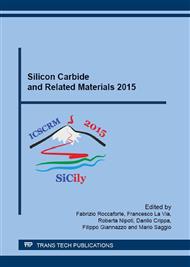p.422
p.429
p.433
p.437
p.441
p.445
p.449
p.453
p.457
Analysis of Gate Oxide Nitridation Effect on SiC MOSFETs by Using Hall Measurement and Split C–V Measurement
Abstract:
In this study, 4H–SiC inversion layers were experimentally evaluated by Hall and split C–V measurements, and scattering mechanisms related to gate oxide nitridation were analyzed. Three typical samples with different crystal plane directions and gate oxidation conditions were prepared, and their total trap density and Hall mobility were compared. Based on the temperature dependence of the Hall mobility, we found that scattering mechanisms differed for each sample. The sample C-face oxynitride which had a high nitrogen density at the metal–oxide–semiconductor (MOS) interface, showed a similar temperature dependency to that of ionized impurity scattering. This result suggests that high-density nitrogen acts as donors that supply free carriers and cause ionized impurity scattering, just like in a bulk crystal. In addition, the sample C-face wet has lowest influence of the Coulomb scattering because of the lowest temperature dependence of Hall mobility and the lowest total trap density.
Info:
Periodical:
Pages:
441-444
Citation:
Online since:
May 2016
Keywords:
Price:
Сopyright:
© 2016 Trans Tech Publications Ltd. All Rights Reserved
Share:
Citation:


